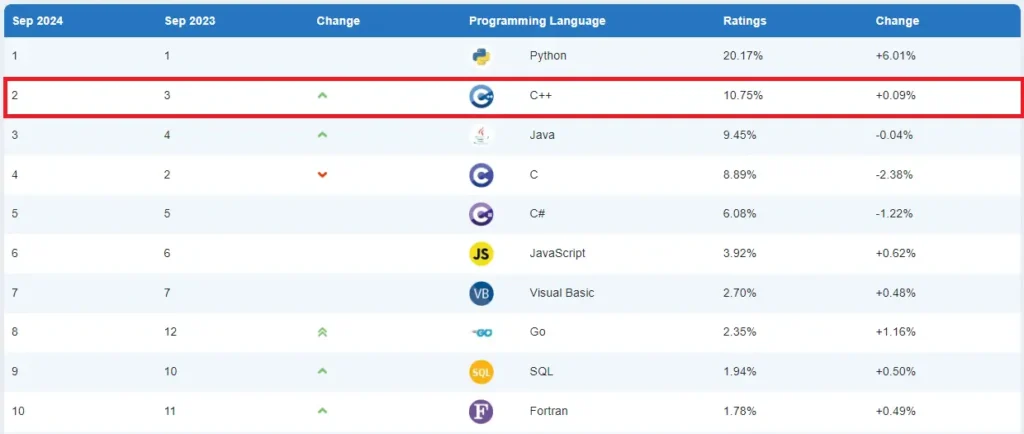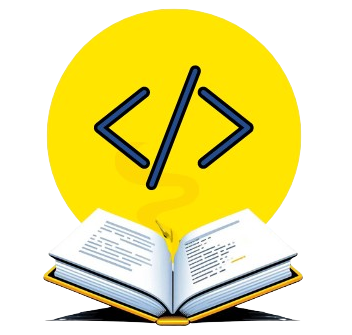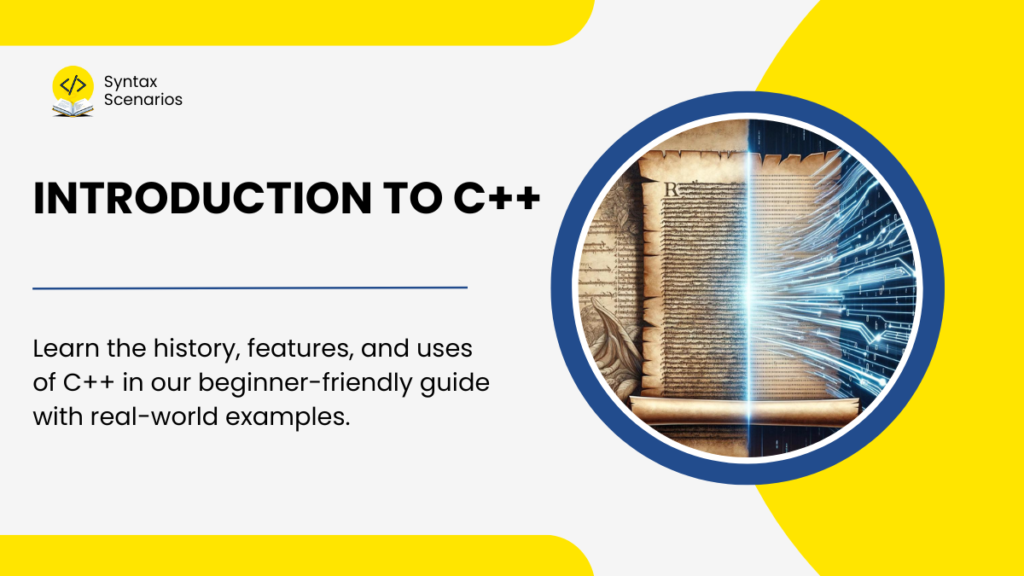Learn the history, features, and uses of C++ in our beginner-friendly guide with real-world examples.
Table of Contents
History of C++
C++ was invented by Bjarne Stroustrup, a Danish computer scientist in 1979 at AT&T Bell Labs. C++ is a high-level general-purpose language which is a successor to the C language. C was enhanced with the addition of numerous object-oriented features like classes and objects, exceptional handling, new data types, function and operator overloading etc.
It was once known as “c with objects” Later as the language evolved, Stroustrup gave the language its current name C++ in 1983. Since the ++ is an increment operator of C, the term C++ implies “C incremented.”
Features of C++
C++ is a multi-paradigm programming language known for its power, efficiency, and versatility. Some of its key features include:
OOP (Object-Oriented Programming)
Encapsulation, inheritance, abstraction, and polymorphism are fundamental concepts in C++ that make it easier to manage complex programs. These concepts help you represent real-world objects like cars, bank, ATMs, product, etc and their interactions in your code, reducing complexity when designing applications that involve such real-world objects.
Multi-threading
Multithreading in programming is like having multiple employees in a bakery, each working on a different task at the same time to make the baking process faster and more efficient. Instead of one person doing everything sequentially, you have one person mixing dough, another baking cookies, and another decorating cakes simultaneously.
Similarly, multithreading allows your program to create multiple threads, or mini-programs, that run concurrently to perform different tasks at the same time, improving performance on multi-core CPUs.
Dynamic memory allocation
Dynamic memory allocation in C++ is like a bakery that can adjust the number of ovens and storage shelves based on the current demand, instead of being fixed. Just as a bakery might need to add more ovens during a busy season or remove some when it’s slow.
Dynamic memory allocation allows your program to allocate memory for objects at runtime based on current needs, rather than at compile time. This flexibility efficiently manages large data and creates dynamic data structures, ensuring that memory resources are used effectively.
Function Overloading
Function overloading in C++ is like having different recipes in a bakery that share the same name but require slightly different ingredients or processes. For example, you might have a recipe for “cookies” that can be made with chocolate chips or raisins, each requiring different amounts of flour, sugar and the process.
Similarly, in C++, you can define multiple functions with the same name that do slightly different tasks based on the input provided. For example, you can define two functions named login. One will log in using email and a password and the other will log in using the phone number and password.
Operator Overloading
Operator overloading in C++ is similar to using a versatile kitchen knife in a bakery. Just as you can use a single sharp knife to cut various ingredients like vegetables, fruits, meats, etc.
Similarly, in C++, operator overloading allows you to redefine how operators work in different scenarios. For instance, you can use the + operator to add numbers or concatenate(combine) strings. Similarly, you might redefine the - operator to subtract numbers or remove elements from a list.
Uses of C++
The uses and popularity of C++ in 2024 can be clearly determined by the TIOBE index ratings. As of 2024, C++ has gained a positive change in ratings of 0.09% compared to 2023. The current rating is 10.75 which makes it the second most popular language after Python.

The graph below shows the increasing change in ratings of C++ popularity and usage for each year. It has been the “language of the year” in 2003 and 2022.

Hence, C++ is a versatile and powerful programming language with a wide range of applications across various domains. Some of its primary uses include:
Game Development
Because C++ has excellent performance and can access hardware resources directly, it is used in the development of several well-known video games. C++ is widely used in game engines, such as Unreal Engine and Unity, for essential operations.
CAD and graphics software
Because C++ can handle intricate mathematical computations and manage memory well, it is frequently used in graphics libraries and software. Rendering engines in programs like Blender, AutoCAD, and Adobe Photoshop use C++.
Scientific Computing and Simulation
Because of C++’s high processing efficiency, scientific computing and simulation software frequently use it to enable researchers to carry out intricate simulations and data analysis.
Operating Systems Development
As C++ can efficiently manage system resources and interface closely with hardware, it is widely utilized in operating system development.
Difference between C and C++
| Aspect | C | C++ |
|---|---|---|
| Purpose | Initially designed for OS programming. | Widely used for system/software development, gaming, and large projects. |
| Developer | Developed by Dennis Ritchie in 1972. | Developed by Bjarne Stroustrup in 1979. |
| Paradigm | Procedural – follows top-down approach. | Both procedural and object-oriente So, follows both top-down and bottom-up approaches. |
| Security | Less secure than C++. | Not entirely backwards compatible due to additional features. |
| Syntax | Simpler syntax with fewer keywords. | Builds upon C’s syntax, adding more keywords and functionalities. |
| Compatibility | Programs can be easily incorporated into C++. | Not entirely backward compatible due to additional features. |
| Data Types | Supports built-in data types. | Supports both built-in and user-defined data types. |
Conclusion
To sum up, C++ is a fundamental language that gives programmers power over low-level resources, effectiveness, and adaptability. It is essential in a variety of industries, including gaming, finance, automotive, and aerospace, because of its ability to smoothly combine high-level software abstraction with low-level hardware contact.
Ultimately, every programmer should learn C++ for its powerful nature, efficiency, versatility, and real-world applicability. To begin your journey, explore the data types and variables in C++, and the operators in C++ explained with visuals in our beginner-friendly guides.
FAQs
Who invented C++ and when?
C++ was invented by Bjarne Stroustrup in 1979 at AT&T Bell Labs as a successor to the C programming language, enhancing it with object-oriented features.
What are the main features of C++?
C++ includes object-oriented programming (OOP), multi-threading, dynamic memory allocation, function overloading, and operator overloading, which make it a powerful and flexible language.
What is the difference between C and C++?
C is procedural, focusing on a top-down approach, while C++ supports both procedural and object-oriented paradigms with additional features like classes, security through encapsulation, and user-defined data types.
How is C++ used in game development?
C++ is widely used in game development for its high performance and access to hardware resources. It’s the primary language for game engines like Unreal Engine and Unity, which are used to build many popular video games.
What makes C++ suitable for scientific computing and simulation?
C++ offers high processing efficiency and control over system resources that makes it ideal for scientific computing and simulations that require complex data analysis and fast execution times.

